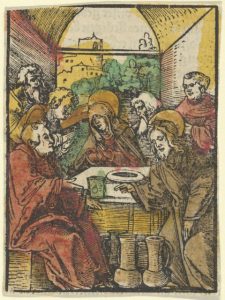
John is the author of the Gospel that bears his name, and his purpose is clear: “Jesus performed many other signs in the presence of his disciples, which are not recorded in this book. But these are written that you may believe that Jesus is the Messiah, the Son of God, and that by believing you may have life in his name” (20:30-31, NIV).
The “signs” Jesus performed “in the presence of his disciples” are recorded in the Gospel “that” (purpose clause #1) “you” (the readers) “may believe that Jesus is the Messiah, the Son of God, and that (purpose clause #2) by believing you may have life in his name.”
This short study is about the first purpose clause: “that you may believe that Jesus is the Messiah, the Son of God.” John selected seven of the many signs Jesus performed. And this study is about the first “sign” (Greek, semeion) which he performed in Cana of Galilee (John 2:1-11).
Jesus and his disciples were at a wedding in Cana when Mary came to him with a problem: “They have no more wine.” Jesus did not act immediately (“my time has not yet come”), but which came soon enough, the time in which to reveal his glory: changed the water into wine! Thus John concludes this story with these words: “What Jesus did here in Cana of Galilee was the first of the signs through which he revealed his glory; and his disciples believed in him” (v11).
It is important to note that John tells us the miracle of the wine is a “sign” (semeion), a theological pointer, if you please, to say something about the performer: “he revealed his glory.” You understand that the “sign” is not primarily about the water-turned-to-wine; it is all about Jesus’ “glory” that is revealed through it. The “sign” was for the disciples to see. Therefore, the question we should be asking is, what “glory” is being referred to here?
Interestingly, this is the second occurrence of “glory” in John. The first mention of “glory” occurs in 1:14 – “The Word became flesh and made his dwelling among us. We have seen his glory, the glory of the one and only Son, who came from the Father, full of grace and truth.”
This statement gives us the clue about the kind of glory John had in mind about Jesus. John writes what the Incarnation is totally about: “We have seen his glory, the glory of the one and only Son, who came from the Father, full of grace and truth.”
The “glory” of Jesus reveals something about him: he is the “one and only Son, who came from the Father.” That is important to point out. The “glory” links Jesus up with the Father – “who came from the Father.” What is the glory that relates Jesus to the Father? That he is “full of grace and truth”! That is the point.
Now we are going somewhere. John’s carefully crafted expression “full of grace and truth” brings us back, I believe, to the Old Testament where we read of Moses pleading with God: “Show me your glory.” Here is the text: “Then Moses said, “Now show me your glory.” And the LORD said, “I will cause all my goodness to pass in front of you, and I will proclaim my name, the LORD, in your presence” (Exo 33:18-19a).
As far as the LORD is concerned, His “glory” equates to His “name, the LORD.” And that is what the LORD did: He “proclaimed” His name to Moses:
“Then the LORD came down in the cloud and stood there with him and proclaimed his name, the LORD. And he passed in front of Moses, proclaiming, “The LORD, the LORD, the compassionate and gracious God, slow to anger, abounding in love and faithfulness, maintaining love to thousands, and forgiving wickedness, rebellion and sin. Yet he does not leave the guilty unpunished; he punishes the children and their children for the sin of the parents to the third and fourth generation.” (Exo 34:5-7).
The operative words about the LORD’s name in this instance are: “abounding in love and faithfulness.” (see Psa 86:15). The “glory” that John and the disciples saw in Jesus reminded them of the “glory” of the LORD’s name which He proclaimed to Moses. The LORD “abounds in love and faithfulness” – exactly the same “glory” of the “One and only Son who came from the Father, full of grace and truth.” Do you see the equivalence here?
Now the Hebrew chesed in “love and faithfulness” (chesed and emet) may be translated “lovingkindness.” And in some instances, simply as “kindness” (eg, Gen 20:13; 21:23; Josh 2:12; 1 Sam 15:6; Est 2:9; 2 Sam 9:1;). We find the exact same combination in Gen 24:49, “deal kindly and truly” (chesed and emet, see also Gen 32:10; 47:29; Josh 2:14; 2 Sam 2:6; Psa 36:5; 40:10, 11; 57:3; 61:7, 13; 85:10; 88:11; 89:14; 98:3; 138:2).
Now back to Cana in Galilee. If we understand that “abounding in kindness,” is the LORD’s glory (Exo 34:6), and John tells us Jesus, who came from the Father, was “full of kindness,” (1:14), then what exactly is the kindness that Jesus show at the wedding in Cana?
They’ve run out of wine! And I can imagine that someone came and whispered something in the groom’s ear. But before the guests would find out about the brewing disaster, Jesus turned the water into wine, and the wedding party went on! Listen to this: Jesus saved the groom and his family from a huge embarrassment, and he treated every guest with the best wine of all! Is it a surprise that Jesus was at the wedding in Cana at all? (see Jn 1:48-50).
